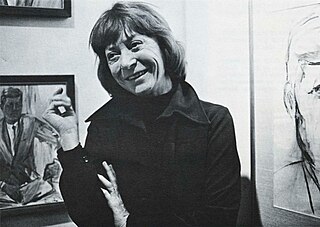
Elaine Marie Catherine de Kooning was an Abstract Expressionist and Figurative Expressionist painter in the post-World War II era. She wrote extensively on the art of the period and was an editorial associate for Art News magazine.

Louise Nevelson was an American sculptor known for her monumental, monochromatic, wooden wall pieces and outdoor sculptures. Born in the Poltava Governorate of the Russian Empire, she emigrated with her family to the United States in the early 20th century. Nevelson learned English at school, as she spoke Yiddish at home.

Lee Bontecou was an American sculptor and printmaker and a pioneer figure in the New York art world. She kept her work consistently in a recognizable style, and received broad recognition in the 1960s. Bontecou made abstract sculptures in the 1960s and 1970s and created vacuum-formed plastic fish, plants, and flower forms in the 1970s. Rich, organic shapes and powerful energy appear in her drawings, prints, and sculptures. Her work has been shown and collected in many major museums in the United States and in Europe.

Vija Celmins is a Latvian American visual artist best known for photo-realistic paintings and drawings of natural environments and phenomena such as the ocean, spider webs, star fields, and rocks. Her earlier work included pop sculptures and monochromatic representational paintings. Based in New York City, she has been the subject of over forty solo exhibitions since 1965, and major retrospectives at the Museum of Modern Art, Whitney Museum of American Art, Los Angeles County Museum of Art, San Francisco Museum of Modern Art, Institute of Contemporary Arts, London and the Centre Pompidou, Paris.

Alice Baber was an American abstract expressionist painter who worked in oil and watercolor. She was educated in the United States and in the 1950s and 1960s she studied and lived in Paris. She also traveled around the world. Baber, a feminist, organized exhibits of women artists' work.

Ethel Kremer Schwabacher was an influential abstract expressionist painter, represented by the Betty Parsons Gallery in the 1950s and 1960s. She was a protégé and first biographer of Arshile Gorky, and friends with many of the prominent painters of New York at that time, including Willem de Kooning, Richard Pousette-Dart, Kenzo Okada, and José Guerrero. She was also the author of a monograph on the artist John Charles Ford and a memoir, "Hungry for Light".
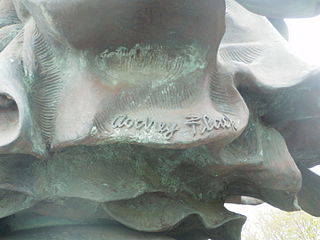
Audrey Flack is an American artist. Her work pioneered the art genre of photorealism and encompasses painting, printmaking, sculpture, and photography.

Alma Woodsey Thomas was an African-American artist and teacher who lived and worked in Washington, D.C., and is now recognized as a major American painter of the 20th century. Thomas is best known for the "exuberant", colorful, abstract paintings that she created after her retirement from a 35-year career teaching art at Washington's Shaw Junior High School.

Betty Parsons was an American artist, art dealer, and collector known for her early promotion of Abstract Expressionism. She is regarded as one of the most influential and dynamic figures of the American avant-garde.

Irene Rice Pereira was an American abstract artist, poet and philosopher who played a major role in the development of modernism in the United States. She is known for her work in the genres of geometric abstraction, abstract expressionism and lyrical abstraction, as well as her use of the principles of the Bauhaus school. Her paintings and writings were significantly influenced by the complex intellectual currents of the 20th century.
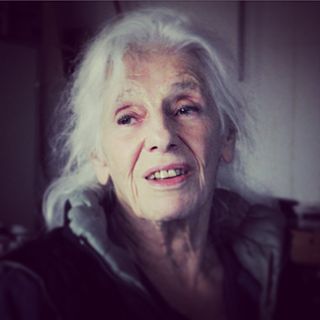
Josephine Gail Baer is an American painter associated with minimalist art. She began exhibiting her work at the Fischbach Gallery, New York, and other venues for contemporary art in the mid-1960s. In the mid-1970s, she turned away from non-objective painting. Since then, Baer has fused images, symbols, words, and phrases in a non-narrative manner, a mode of expression she once termed "radical figuration." She lives and works in Amsterdam, Netherlands.
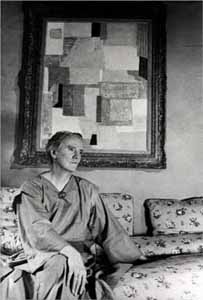
Anne Ryan (1889–1954) was an American Abstract Expressionist artist associated with the New York School. Her first contact with the New York City avant-garde came in 1941 when she joined the Atelier 17, a famous printmaking workshop that the British artist Stanley William Hayter had established in Paris in the 1930s and then brought to New York when France fell to the Nazis. The great turning point in Ryan's development occurred after the war, in 1948. She was 57 years old when she saw the collages of Kurt Schwitters at the Rose Fried Gallery, in New York City, in 1948. She right away dedicated herself to this newly discovered medium. Since Anne Ryan was a poet, according to Deborah Solomon, in Kurt Schwitters’s collages “she recognized the visual equivalent of her sonnets – discrete images packed together in an extremely compressed space.” When six years later Ryan died, her work in this medium numbered over 400 pieces.

Janet Fish is a contemporary American realist artist. Through oil painting, lithography, and screenprinting, she explores the interaction of light with everyday objects in the still life genre. Many of her paintings include elements of transparency, reflected light, and multiple overlapping patterns depicted in bold, high color values. She has been credited with revitalizing the still life genre.
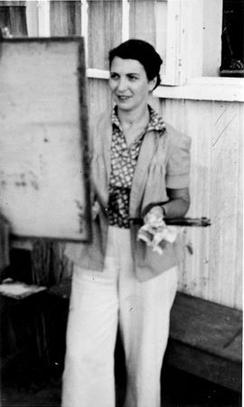
Perle Fine (1905–1988) was an American Abstract expressionist painter. Fine's work was most known by its combination of fluid and brushy rendering of the materials and the use of biomorphic forms encased and intertwined with irregular geometric shapes.

Suzy Frelinghuysen, also known as Suzy Morris, was an American abstract painter and opera singer.
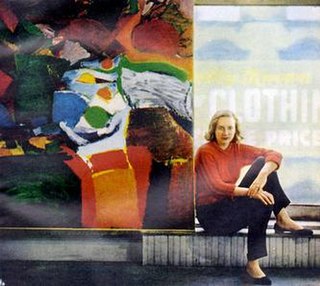
Grace Hartigan was an American Abstract Expressionist painter and a significant member of the vibrant New York School of the 1950s and 1960s. Her circle of friends, who frequently inspired one another in their artistic endeavors, included Jackson Pollock, Larry Rivers, Helen Frankenthaler, Willem and Elaine de Kooning and Frank O'Hara. Her paintings are held by numerous major institutions, including the Museum of Modern Art in New York City. As director of the Maryland Institute College of Art's Hoffberger School of Painting, she influenced numerous young artists.
Cecilia Roser, who works under the name Ce Roser, was born in Philadelphia, Pennsylvania in 1925. Roser has been active in New York City as an artist since the 1960s. Ever since childhood, Roser had been painting and drawing. While studying in Berlin, Roser learned of a female artist named Käthe Kollwitz. Kollwitz, who worked until the day she died, was an inspiration to Roser. Remarking that she would like to live that way too, Roser proceeded to emphasize the need for young artists, especially women, to find a fitting predecessor and mentor.
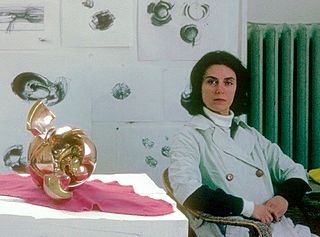
Luise Clayborn Kaish was an American artist known for her work in sculpture, painting, and collage. Throughout her career, Kaish's work was exhibited and collected by major museums, including the Smithsonian Institution's National Museum of American Art, the Museum of Modern Art, the Whitney Museum, the Jewish Museum, and the Metropolitan Museum of Art. Kaish created monumental sculptures in bronze, aluminum, and stainless steel, which remain on view in educational, religious, and commercial settings across the United States and internationally.
Mary Weatherford is a Los Angeles–based painter. She is known for her large paintings incorporating neon lighting tubes. Her work is featured in museums and galleries including the Hirshhorn Museum and Sculpture Garden, Brooklyn Museum, Museum of Modern Art, and the High Museum of Art. Weatherford's solo exhibitions include Mary Weatherford: From the Mountain to the Sea at Claremont McKenna College, I've Seen Gray Whales Go By at Gagosian West, and Like The Land Loves the Sea at David Kordansky Gallery, Los Angeles. Her work has been part of group exhibitions at the Museum of Modern Art and the Rose Art Museum at Brandeis University.

Roland Reiss was an American artist known for his miniature tableaux and paintings.



















